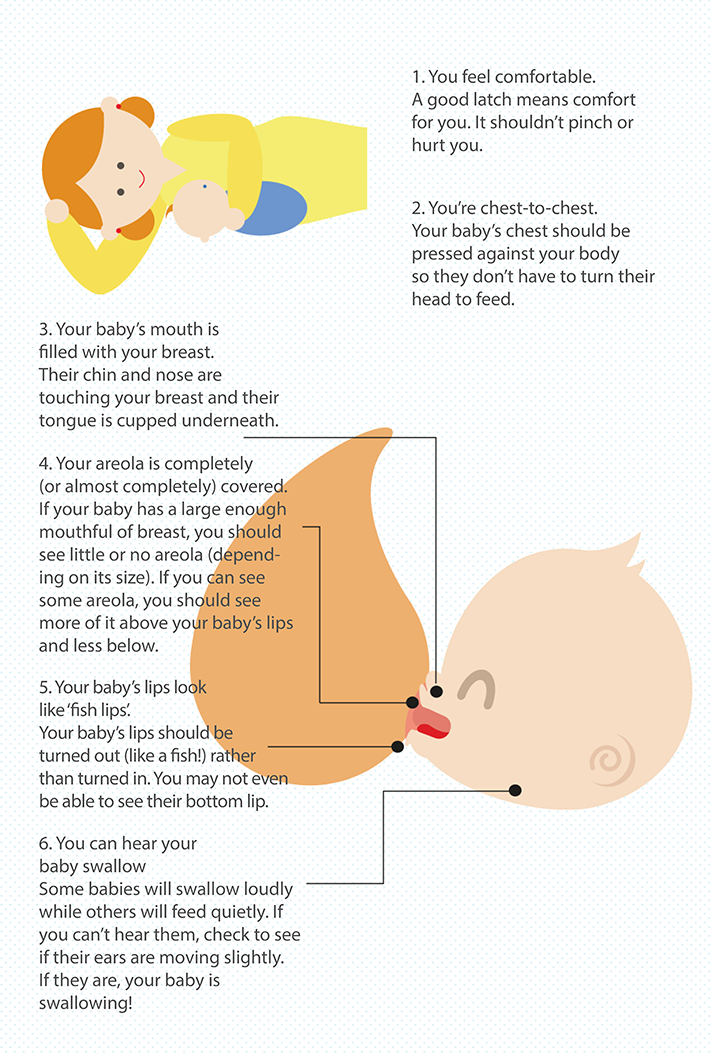
When your baby connects to your breast and creates a seal with their mouth it’s called ‘latching on’.
A good latch will help ensure your baby is feeding properly and is often the key to comfortable, satisfying breastfeeding. But getting a good latch can take a little practice for some mums and babies.
The good news is that getting a good latch is a skill you can both learn! Even if you find it challenging at first, you’ll soon get the hang of it with a little patience and practice. If you don’t get a perfect latch the first few times, don’t worry. You soon will. Remember that breastfeeding has lifelong health benefits for your baby so taking a short time now to learn to latch is well worth it.
Follow these top tips to get ready to breastfeed your baby, then check your positioning against the illustrations below:
1. Tickle
When your baby is at your breast and ready to eat, tickle their lips with your nipple until their mouth is wide open.
2. Cuddle
Bring your baby close to your breast (rather than moving your breast towards them) and make sure their chin and lower jaw touch your breast first.
3. Position
Your baby’s lower lip should be far away from the bottom of your nipple. This is because you want them to take a large mouthful of your breast, not just your nipple.
6 signs of a good latch

Common questions
Q: It hurts a bit! Is that normal?
A: Some tenderness and even pain in the beginning isn’t unusual but over time, once you and your baby have mastered this skill, you shouldn’t be feeling pain. Check your baby is taking a large mouthful of breast – sucking on just your nipple can cause discomfort. If this happens, break your baby’s suction by gently putting a clean finger into the corner of their mouth. Then start at step 1 (Tickle, above) and encourage your little one to latch on properly, again.
Q: I’m not sure my baby’s sucking when he feeds. Could he have a weak suck?
A: If your baby is not latched on properly, they might not be able to remove milk from your breast when he feeds. If you feel he’s latched on correctly but still feel that his sucking is weak or wonder if he’s getting enough breast milk, talk to a lactation specialist or another healthcare provider.
Q: My baby is getting frustrated… and so am I! What can we do?
A: Relax. Take a deep breath, have a little break then try again. You might want to try another position or try some skin-to-skin contact by placing your little one on your chest. Soothe them by talking calmly or singing. When a baby is hungry, they will open their mouth and search for the nipple and be calm and alert. If your little one begins to cry and get agitated, it may be because they are frustrated and hungry. Once you’re both comfortable, calm, and relaxed, try latching on again. Remember that practice does make perfect. Be patient with yourself. You’re doing a great job!
Q: My breasts feel very full and my baby’s having trouble latching on. What can I do?
A: You could try expressing a little milk by hand or pump before you breastfeed. This will relieve the pressure and soften your breasts so your baby can latch on. Overfull breasts are sometimes called ‘engorged’. If you feel your breasts are engorged between feeds, breastfeed or pump every two hours for relief. Remember, your newborn baby should be breastfed at least 8 to 12 times every 24 hours!



















